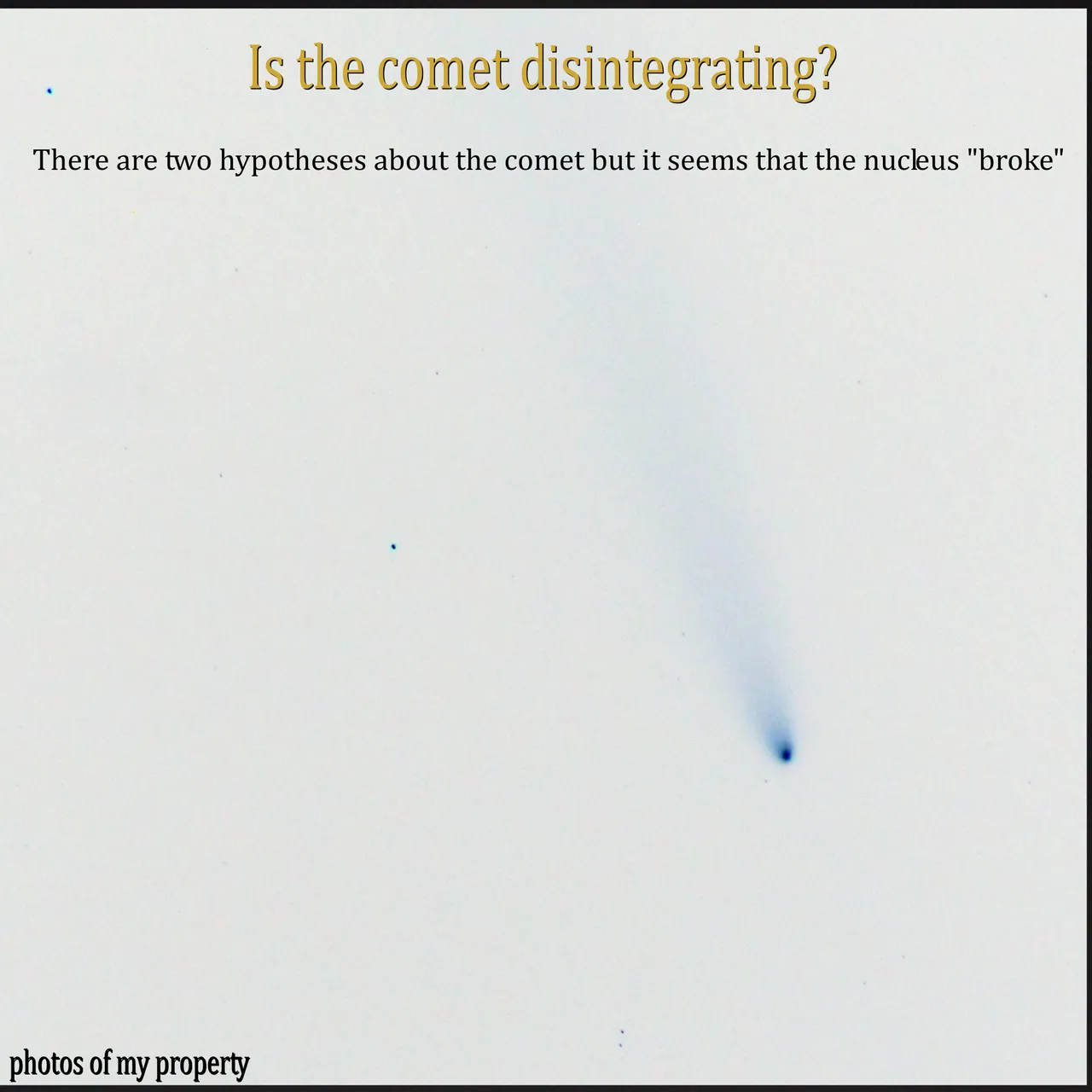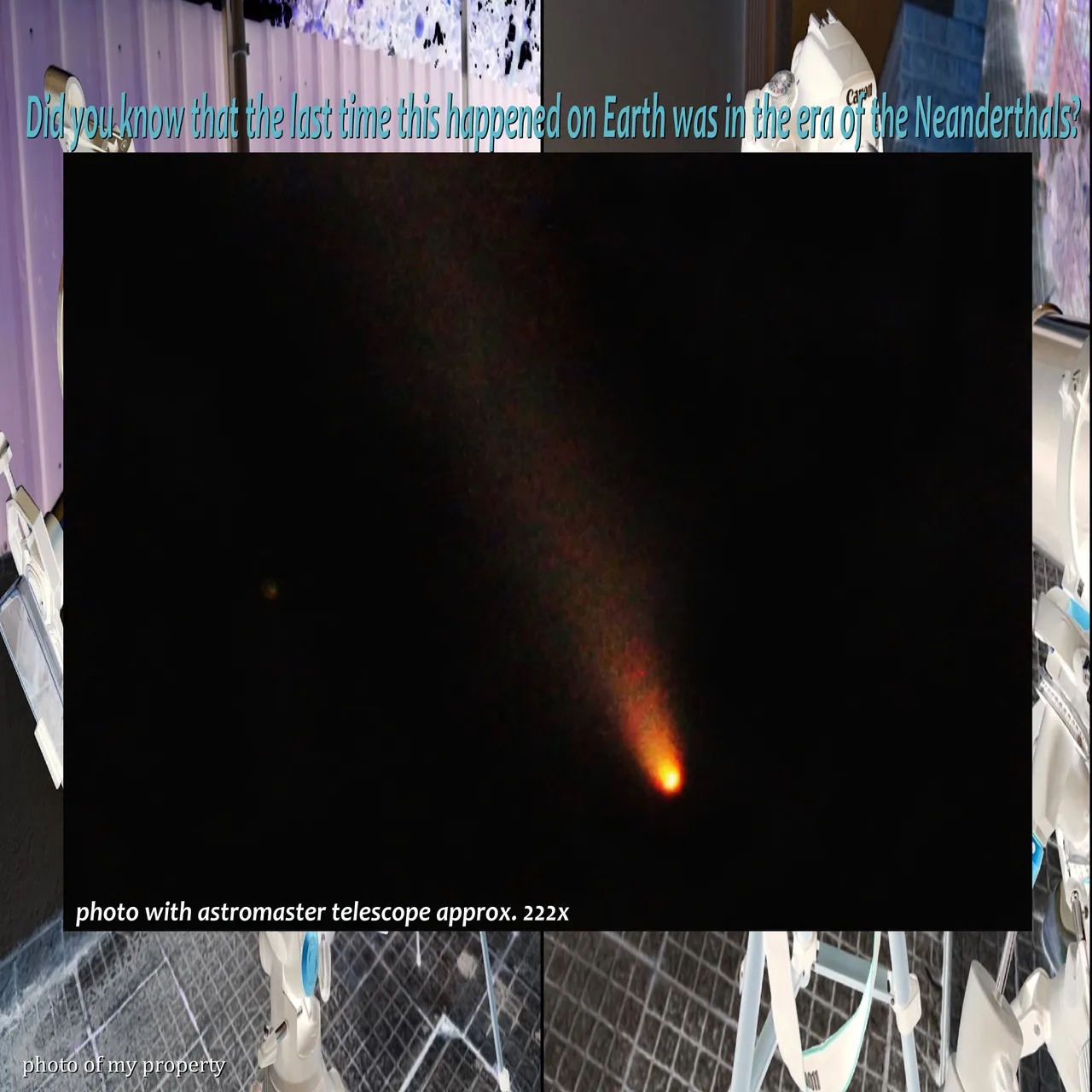Hello science-loving friends! I clearly couldn't pass up a post where I'll explain about the popular "comet of the century", you've probably already read some news about it, or better yet you've already seen it in the sky, isn't it funny that hundreds or thousands of comets pass through the sky annually and none has as much relevance as (C/2024 S1 ATLAS), this tells us that there must be something special about this comet that suggests such relevance in today's world of astronomy; In my post we're going to learn about this beautiful comet and of course why not see it in my telescope?.☄️🤓
Hola amigos amantes de la ciencias! claramente no podia dejar pasar un post donde explicara sobre el popular "cometa del siglo", probablemente ya leiste alguna noticia sobre el, o mejor aun ya lo viste en el cielo, no es gracioso que en el cielo pasen cientos o miles de cometas anualmente y ninguno tiene tanta relevancia como (C/2024 S1 ATLAS), esto nos indica que debe haber algo especial en este cometa que sugiera tanta relevancia en el mundo actual de la astronomia; en mi post vamos aprender sobre este hermoso cometa y claro por que no verlo en mi telescopio?.🧑🏻🎓🔭🔭

Why is it the comet of the century?🔭🧑🏻🎓/Por que es el cometa del siglo?🤓☄️

The comet of the century or whose name was given: (C / 2024 S1 (ATLAS) is a comet of the type: (Kreutz) are those that due to the orbit pass very close to the sun! It was discovered this same year, according to astronomers it will pass at its closest point to the "barycenter of the solar system", it will not be a danger to us because despite being seen with the naked eye it will be "1.2 million km away!" "wikipedia" The comet has several characteristics that cataloged it as the comet of the century, firstly because it can be witnessed and photographed without using telescopes, secondly which for me is the most important fact! It has an orbit of 80,660 years, meaning the last time it passed by the earth was when our species were Neanderthals, incredible, right?🤓☄️
El cometa del siglo o cuyo nombre fue dado: (C/2024 S1 (ATLAS) es un cometa del tipo: (de Kreutz) son aquellos que debido a la orbita pasan muy cerca del sol! fue descubierto este mismo ano, segun los astronomos pasara en su punto mas proximo al "baricentro del sistema solar", no resultara un peligro para nosotros porque apesar de ser visto a simple vista estara a 1,2 millones de km!, el cometa reune varias caracteristicas que lo catalogaron como el cometa del siglo, primeramente porque se podra presenciar y fotografiar sin usar telescopios, segundo que para mi es el dato mas importante! tiene una orbita de 80,660 años osea la ultima vez que paso por la tierra fue cuando nuestra especie era neandertales increible no?🧑🏻🎓🪐🌌
https://starwalk.space/pt/news/new-kreutz-sungrazer-comet-atlas-2024

About comet C/2024 S1 (ATLAS)🔭🧑🏻🎓/Sobre el cometa C/2024 S1 (ATLAS)🤓☄️

Previously the comet had the name of: (A11bP7I), the day to see it best with the naked eye was between October 12 and 14 while the closest day from Earth will be October 23 where it will reach a magnitude of 9.0, in the Periphery which is October 28 it is also recommended to observe it in this phase it will be with a magnitude of -3.3! We cannot expect predictable behavior from a comet, on the contrary, you should check the updates because sometimes they disappear, they disintegrate! When the comet was discovered it had a "greenish" color possibly due to diatomic carbon. When it was discovered it was in the constellation "Hydra".🧑🏻🎓🪐☄️
anteriormente el cometa tenia el nombre de: (A11bP7I), el dia para verlo mejor a simple vista fue entre el 12,14 de octubre mientras el dia mas proximo de la tierra sera el 23 de octubre donde alcanzara una maginitud de 9.0, en el Periélio que es el 28 de octubre tambien se recomienda observalo en esta fase estara con una magnitud de -3.3! no podemos esperar de un cometa un comportamiento predecible todo lo contrario debe ir revisando las actualizaciones ya que en ocasiones desaparecen, de desintegran! cuando el cometa se descubrio tenia una coloracion "verdosa" posiblemente por el carbono diatomico. Cuando se descubrio fue en la constelacion de "hydra".🔭🤓
https://en.wikipedia.org/wiki/C/2024_S1_(ATLAS)

How to watch C/2024 S1 (ATLAS)🔭🧑🏻🎓/Como ver el C/2024 S1 (ATLAS)🤓☄️

Depending on the day in October the comet could be seen in several ways, I already indicated above the date to see it with the "naked eye" or using binoculars, however with a decent telescope we could see it with more details and photograph it even with our phone, but how do we know where in the sky it is? This question is important because we do not know where to point the telescope in the sky, I recommend you use the application (Sky Tonight) it is free and when you point it at the sky it tells you exactly where the comet is moving!🪐☄️
Dependiendo del dia de octubre el cometa podria ser visto de varias formas, ya indique anteriormente la fecha para verlo a "ojo desnudo" o usando binoculares, sin embargo con un telescopio decente podriamos verlo con mas detalles y fotografiarlo hasta con nuestro telefono, pero como sabemos en que parte del cielo esta? esta pregunta es importante porque no sabemos donde apuntar con el telescopio en el cielo, yo te recomiendo usar la aplicacion (Sky Tonight) es gratis y cuando apuntas al cielo te dice exactamente donde esta desplazandose el cometa! 🔭🌌
https://sky-tonight-star-gazer-guide.softonic.com/android

What will happen to the comet?🔭🧑🏻🎓/Que pasara con el cometa?🤓☄️

This is the question that I would say 80% of people don't know, and of course we are here to answer it and learn, what will happen now with the comet? Will it continue on its course? Will it disintegrate because it is so close to the sun and the vapors are consumed more quickly? Astronomers have already confirmed that the nucleus of the comet suffered a rupture, this due to the intense release of gas and rotation of the comet itself, is this why we can see it in the sky? Of course, this fragmentation of the "nucleus" caused dust and gases to be released, which is what we see in the night sky, there is a hypothesis that if the "head" of the comet breaks we could still see it shine in the sky again.🔭☄️
Esta es la pregunta que diria que el 80% de las personas no saben, y claro estamos aqui para responderla y aprender, que sucedera ahora con el cometa? continuara rumbo? se desintegrara por causa de estar proximo del sol y los vapores se consumen de forma mas rapida?, los astronomos ya confirmaron que el nucleo del cometa sufrio una ruptura, esto debido a la intensa liberacion de gas y rotacion del propio cometa, esto se debe a que podamos verlo en el cielo? por supuesto, esa fragmentacion del "nucleo" hizo que se liberara polvo y gases que es lo que vemos en el cielo nocturno, hay una hipotesis que si se rompe la "cabeza" del cometa podriamos verlo aun brillar en el cielo nuevamente.🧑🏻🎓🌎
https://starwalk.space/pt/news/new-kreutz-sungrazer-comet-atlas-2024

View with the astromaster🔭🧑🏻🎓/Vista con el astromaster🤓☄️

Clearly with the telescope we can't see the color of the comet, I have to use filters, for this I use the telescope filter and edit it on the computer, but the proximity and the details that we see with the eq130 is quite good, actually with more time I would have been able to see the head of the comet in more detail but I was in a poorly lit area and it wasn't recommended! For this activity it's better to go to the countryside where light pollution is low or non-existent!🔭🌌
Claramente con el telescopio no podemos ver el color del cometa tengo que usar filtros, para ello uso el filtro del telescopio y lo edito en la computadora, pero la proximidad y los detalles que vemos con el eq130 es bastante buena en realidad con mas tiempo hubiese podido ver la cabeza del cometa con mas detalle pero estaba en una zona un poco iluminada y no era lo recomendable! para esta actividad es mejor ir al campo donde la contaminacion luminica es baja o nula!🪐🤓
Source: My experience


C/2024 S1 (ATLAS) the letter (c) means non-periodic comet, (2024 S1) this says that it was discovered in 2024 and the month of September, and finally ATLAS was the discoverer who was the impact detection system on Earth, which if I'm not mistaken is in Hawaii.🔭🌎
C/2024 S1 (ATLAS) la letra (c) significa cometa no periodico, (2024 S1) esto dice que fue descubierto en el 2024 y el mes de septiembre, y por ultimo ATLAS fue el descubridor que fue el sistema de deteccion de impactos en la tierra, que si no me equivoco es en hawai.🧑🏻🎓🤓☄️
https://starwalk.space/pt/news/new-kreutz-sungrazer-comet-atlas-2024














